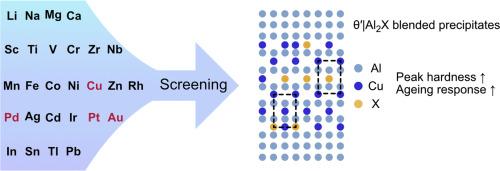Rationalising the Role of Microalloying Additions in Blended Precipitation
IF 8.3
1区 材料科学
Q1 MATERIALS SCIENCE, MULTIDISCIPLINARY
引用次数: 0
Abstract
The precipitation of (Al2Cu) in Al-Cu alloys is greatly influenced by microalloying elements. Combining high-resolution scanning transmission electron microscopy (STEM) with density functional theory (DFT) and classical nucleation theory (CNT) calculations, we have investigated the generality of a recently discovered mechanism that enhances the precipitation of the precipitate phase through the dissolution of trace Au additions within . We have designed a workflow to systematically screen chemical elements and found that, Pd and Pt can also enhance the precipitation of by the same mechanism as Au. All these three elements are found to substitute Cu atoms within , forming what we call “blended precipitates,” namely, precipitates containing regions of both and another phase of nearly identical crystal structure (i.e., (Al2Au), Al2Pt or Al2Pd). According to our calculations, enhanced precipitation originates from the lowering of different energy contributions to the substitution of Cu atoms. Among these elements, Pt is the most promising choice for microalloying in the Al-Cu alloy system as it decreases both the formation energy of the blended precipitate phase as well as the energy of its interface with the Al matrix. This work illustrates the effectiveness of the workflow developed here and should stimulate the exploration of other alloy systems displaying blended precipitate phases, with potentially improved mechanical properties.

微合金化添加剂在共混析出中的作用合理化
微合金化元素对Al-Cu合金中θ′(Al2Cu)的析出有较大影响。结合高分辨率扫描透射电子显微镜(STEM)、密度泛函理论(DFT)和经典成核理论(CNT)计算,我们研究了最近发现的一种机制的普遍性,该机制通过在θ ‘内添加微量Au的溶解来增强θ ’沉淀相的析出。我们设计了一个系统筛选化学元素的工作流程,发现Pd和Pt也能以与Au相同的机制促进θ '的沉淀。所有这三种元素都被发现取代了θ′内的Cu原子,形成了我们所说的“混合沉淀”,即含有θ′和另一相几乎相同晶体结构(即η (Al2Au), Al2Pt或Al2Pd)的沉淀。根据我们的计算,增强的沉淀源于Cu原子取代的不同能量贡献的降低。在这些元素中,Pt是Al- cu合金体系中最有希望的微合金化选择,因为它既降低了θ′混合析出相的形成能,又降低了它与Al基体的界面能。这项工作说明了这里开发的工作流程的有效性,并应该刺激对其他合金系统的探索,显示混合沉淀相,具有潜在的改善机械性能。
本文章由计算机程序翻译,如有差异,请以英文原文为准。
求助全文
约1分钟内获得全文
求助全文
来源期刊

Acta Materialia
工程技术-材料科学:综合
CiteScore
16.10
自引率
8.50%
发文量
801
审稿时长
53 days
期刊介绍:
Acta Materialia serves as a platform for publishing full-length, original papers and commissioned overviews that contribute to a profound understanding of the correlation between the processing, structure, and properties of inorganic materials. The journal seeks papers with high impact potential or those that significantly propel the field forward. The scope includes the atomic and molecular arrangements, chemical and electronic structures, and microstructure of materials, focusing on their mechanical or functional behavior across all length scales, including nanostructures.
 求助内容:
求助内容: 应助结果提醒方式:
应助结果提醒方式:


